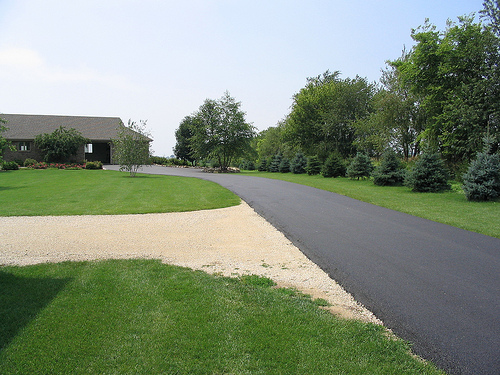Coal Tar-Based Pavement Sealants
 Coal tar-based sealants are applied to asphalt pavements in order to protect the pavement from wear and increase aesthetic appeal. They are commonly used on driveways, parking lots, and playgrounds in parts of Canada and the United States. Coal tar-based sealants are known to contain high levels of polycyclic aromatic hydrocarbons (PAHs). The concentration of PAHs has been found to exceed 50,000 mg/kg in sealants with a coal tar base, which is approximately 1,000 times greater than in sealants with an asphalt base (1). PAHs are produced during the combustion of carbon-based materials and are an environmental and human health concern.
Coal tar-based sealants are applied to asphalt pavements in order to protect the pavement from wear and increase aesthetic appeal. They are commonly used on driveways, parking lots, and playgrounds in parts of Canada and the United States. Coal tar-based sealants are known to contain high levels of polycyclic aromatic hydrocarbons (PAHs). The concentration of PAHs has been found to exceed 50,000 mg/kg in sealants with a coal tar base, which is approximately 1,000 times greater than in sealants with an asphalt base (1). PAHs are produced during the combustion of carbon-based materials and are an environmental and human health concern.
When coal tar-based sealants are applied to a paved surface, PAHs can enter the environment through several pathways. Over time, the paved surface is abraded by vehicles and foot traffic which releases fine particles containing PAHs. These particles adhere to objects such as vehicle tires and shoes and can be carried offsite or indoors. They can also be dispersed by the wind or washed into storm drains by the rain and conveyed to lakes and rivers. Some PAHs volatilize from paved surfaces.
A number of PAHs are toxic to mammals, birds, fish, amphibians, and plants. PAHs typically accumulate in lake and river bed sediments, posing a particular risk to the aquatic invertebrates that live in these habitats. The concentration of PAHs in urban lake sediment has been increasing since the 1960s and this trend has been attributed primarily to the use of coal tar-based sealants (2). Seven PAHs are probable human carcinogens (3). Humans can be exposed to PAHs via ingestion of fine particles, skin contact with the pavement surface or with objects that have touched it, or inhalation of airborne particles and fumes (2).
Several alternatives to coal tar-based sealants are available on the market today, including: (i) asphalt-based sealants, (ii) Gilsonite®, (iii) acrylic seals, and (iv) agricultural oil-based seals. By substituting an alternative sealant that is lower in PAHs or PAH-free, homeowners and property managers can effectively protect paved surfaces while reducing risks to the environment and human health. However, it should be noted that although the use of alternative sealants may improve the quality of urban runoff, these products do not address runoff quantity concerns. To mitigate the volume of runoff created by urban landscapes, impermeable surfaces should be replaced with pervious materials that allow for infiltration of rainfall and snowmelt such as permeable pavements or gravel.
Photo Credit: Jim George and Sons via Compfight cc
Sources:
(1) City of Austin. 2005. PAHs in Austin, Texas: Sediments and coal-tar based pavement sealants. Draft report. Online document: http://www.ci.austin.tx.us/watershed/downloads/coaltar_draft_pah_study.pdf. Accessed July 16, 2014.
(2) United States Geological Survey (USGS). 2011. Coal-Tar-Based Pavement Sealcoat, Polycyclic Aromatic Hydrocarbons (PAHs), and Environmental Health. Fact Sheet 2011–3010. Online document: http://pubs.usgs.gov/fs/2011/3010/pdf/fs2011-3010.pdf. Accessed July 16, 2014.
(3) U.S. Environmental Protection Agency. 2009. Integrated Risk Information System (IRIS): http://cfpub.epa.gov/ncea/iris/index.cfm. Accessed July 16, 2014.
